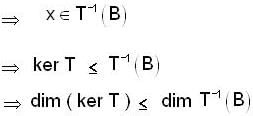Mathematics Exam > Mathematics Questions > Let T : V → w be a linear transformation...
Start Learning for Free
Let T : V → w be a linear transformation, where V is a finite dimensional vector space. Let B be a subspace of W, then
- a)T-1 (B) = φ
- b)T-1 (B) is a subspace of V
- c)dim ( ker T ) ≤ dim (T-1 (B))
- d)dim(T-1 (B)) ≤ dim (ker T)
Correct answer is option 'B,C'. Can you explain this answer?
Verified Answer
Let T : V → w be a linear transformation, where V is a finite dim...
Since T is a Linear Transformation ⇒ T(0) = 0 ' ∈w
Hence T(O) = 0 ' ∈ B (∴ B be a subspace of W ).






Hence T(O) = 0 ' ∈ B (∴ B be a subspace of W ).






Most Upvoted Answer
Let T : V → w be a linear transformation, where V is a finite dim...
Since T is a Linear Transformation ⇒ T(0) = 0 ' ∈w
Hence T(O) = 0 ' ∈ B (∴ B be a subspace of W ).






Hence T(O) = 0 ' ∈ B (∴ B be a subspace of W ).






Free Test
FREE
| Start Free Test |
Community Answer
Let T : V → w be a linear transformation, where V is a finite dim...
Be a linear operator on a finite-dimensional vector space V. Suppose that the only eigenvalues of T are scalars λ1, λ2, ..., λk. Prove that the characteristic polynomial of T is equal to (x - λ1)(x - λ2)...(x - λk).
Proof:
Let n be the dimension of V. Since T is a linear operator on V, we can represent T by a matrix A with respect to some basis of V. Let {v1, v2, ..., vn} be a basis of V. Then we can write Tvj as a linear combination of {v1, v2, ..., vn} for each j = 1, 2, ..., n.
Suppose that λ is an eigenvalue of T and let v be an eigenvector corresponding to λ. Then we have Tv = λv. Writing v as a linear combination of {v1, v2, ..., vn}, we have v = a1v1 + a2v2 + ... + anvn for some scalars a1, a2, ..., an.
Now, applying T to both sides of the equation, we have Tv = T(a1v1 + a2v2 + ... + anvn). By linearity of T, this becomes λv = a1Tv1 + a2Tv2 + ... + anTvn.
Since {v1, v2, ..., vn} is a basis, we can express each Tvi as a linear combination of {v1, v2, ..., vn}. Let Tvi = b1v1 + b2v2 + ... + bnvn for each i = 1, 2, ..., n.
Substituting these expressions into the equation above, we have λ(a1v1 + a2v2 + ... + anvn) = a1(b1v1 + b2v2 + ... + bnvn) + a2(b1v1 + b2v2 + ... + bnvn) + ... + an(b1v1 + b2v2 + ... + bnvn).
Expanding both sides and regrouping terms, we have (λ - b1)a1v1 + (λ - b2)a2v2 + ... + (λ - bn)anvn = 0.
Since {v1, v2, ..., vn} is linearly independent, the coefficients of each vi must be zero. This gives us a system of n linear equations in the variables a1, a2, ..., an. Since v is nonzero, at least one of the ai must be nonzero.
Since λ is an eigenvalue, the system of equations above has a nonzero solution. This means that the determinant of the coefficient matrix of the system is zero. Therefore, we have (λ - b1)(λ - b2)...(λ - bn) = 0.
Since λ can be any eigenvalue of T, we have the characteristic polynomial of T as (x - λ1)(x - λ2)...(x - λk), where λ1, λ2, ..., λk are the eigenvalues of T.
Proof:
Let n be the dimension of V. Since T is a linear operator on V, we can represent T by a matrix A with respect to some basis of V. Let {v1, v2, ..., vn} be a basis of V. Then we can write Tvj as a linear combination of {v1, v2, ..., vn} for each j = 1, 2, ..., n.
Suppose that λ is an eigenvalue of T and let v be an eigenvector corresponding to λ. Then we have Tv = λv. Writing v as a linear combination of {v1, v2, ..., vn}, we have v = a1v1 + a2v2 + ... + anvn for some scalars a1, a2, ..., an.
Now, applying T to both sides of the equation, we have Tv = T(a1v1 + a2v2 + ... + anvn). By linearity of T, this becomes λv = a1Tv1 + a2Tv2 + ... + anTvn.
Since {v1, v2, ..., vn} is a basis, we can express each Tvi as a linear combination of {v1, v2, ..., vn}. Let Tvi = b1v1 + b2v2 + ... + bnvn for each i = 1, 2, ..., n.
Substituting these expressions into the equation above, we have λ(a1v1 + a2v2 + ... + anvn) = a1(b1v1 + b2v2 + ... + bnvn) + a2(b1v1 + b2v2 + ... + bnvn) + ... + an(b1v1 + b2v2 + ... + bnvn).
Expanding both sides and regrouping terms, we have (λ - b1)a1v1 + (λ - b2)a2v2 + ... + (λ - bn)anvn = 0.
Since {v1, v2, ..., vn} is linearly independent, the coefficients of each vi must be zero. This gives us a system of n linear equations in the variables a1, a2, ..., an. Since v is nonzero, at least one of the ai must be nonzero.
Since λ is an eigenvalue, the system of equations above has a nonzero solution. This means that the determinant of the coefficient matrix of the system is zero. Therefore, we have (λ - b1)(λ - b2)...(λ - bn) = 0.
Since λ can be any eigenvalue of T, we have the characteristic polynomial of T as (x - λ1)(x - λ2)...(x - λk), where λ1, λ2, ..., λk are the eigenvalues of T.

|
Explore Courses for Mathematics exam
|

|
Question Description
Let T : V → w be a linear transformation, where V is a finite dimensional vector space. Let B be a subspace of W, thena)T-1 (B) =φb)T-1(B) is a subspace of Vc)dim ( ker T )≤dim (T-1 (B))d)dim(T-1(B))≤ dim (ker T)Correct answer is option 'B,C'. Can you explain this answer? for Mathematics 2025 is part of Mathematics preparation. The Question and answers have been prepared according to the Mathematics exam syllabus. Information about Let T : V → w be a linear transformation, where V is a finite dimensional vector space. Let B be a subspace of W, thena)T-1 (B) =φb)T-1(B) is a subspace of Vc)dim ( ker T )≤dim (T-1 (B))d)dim(T-1(B))≤ dim (ker T)Correct answer is option 'B,C'. Can you explain this answer? covers all topics & solutions for Mathematics 2025 Exam. Find important definitions, questions, meanings, examples, exercises and tests below for Let T : V → w be a linear transformation, where V is a finite dimensional vector space. Let B be a subspace of W, thena)T-1 (B) =φb)T-1(B) is a subspace of Vc)dim ( ker T )≤dim (T-1 (B))d)dim(T-1(B))≤ dim (ker T)Correct answer is option 'B,C'. Can you explain this answer?.
Let T : V → w be a linear transformation, where V is a finite dimensional vector space. Let B be a subspace of W, thena)T-1 (B) =φb)T-1(B) is a subspace of Vc)dim ( ker T )≤dim (T-1 (B))d)dim(T-1(B))≤ dim (ker T)Correct answer is option 'B,C'. Can you explain this answer? for Mathematics 2025 is part of Mathematics preparation. The Question and answers have been prepared according to the Mathematics exam syllabus. Information about Let T : V → w be a linear transformation, where V is a finite dimensional vector space. Let B be a subspace of W, thena)T-1 (B) =φb)T-1(B) is a subspace of Vc)dim ( ker T )≤dim (T-1 (B))d)dim(T-1(B))≤ dim (ker T)Correct answer is option 'B,C'. Can you explain this answer? covers all topics & solutions for Mathematics 2025 Exam. Find important definitions, questions, meanings, examples, exercises and tests below for Let T : V → w be a linear transformation, where V is a finite dimensional vector space. Let B be a subspace of W, thena)T-1 (B) =φb)T-1(B) is a subspace of Vc)dim ( ker T )≤dim (T-1 (B))d)dim(T-1(B))≤ dim (ker T)Correct answer is option 'B,C'. Can you explain this answer?.
Solutions for Let T : V → w be a linear transformation, where V is a finite dimensional vector space. Let B be a subspace of W, thena)T-1 (B) =φb)T-1(B) is a subspace of Vc)dim ( ker T )≤dim (T-1 (B))d)dim(T-1(B))≤ dim (ker T)Correct answer is option 'B,C'. Can you explain this answer? in English & in Hindi are available as part of our courses for Mathematics.
Download more important topics, notes, lectures and mock test series for Mathematics Exam by signing up for free.
Here you can find the meaning of Let T : V → w be a linear transformation, where V is a finite dimensional vector space. Let B be a subspace of W, thena)T-1 (B) =φb)T-1(B) is a subspace of Vc)dim ( ker T )≤dim (T-1 (B))d)dim(T-1(B))≤ dim (ker T)Correct answer is option 'B,C'. Can you explain this answer? defined & explained in the simplest way possible. Besides giving the explanation of
Let T : V → w be a linear transformation, where V is a finite dimensional vector space. Let B be a subspace of W, thena)T-1 (B) =φb)T-1(B) is a subspace of Vc)dim ( ker T )≤dim (T-1 (B))d)dim(T-1(B))≤ dim (ker T)Correct answer is option 'B,C'. Can you explain this answer?, a detailed solution for Let T : V → w be a linear transformation, where V is a finite dimensional vector space. Let B be a subspace of W, thena)T-1 (B) =φb)T-1(B) is a subspace of Vc)dim ( ker T )≤dim (T-1 (B))d)dim(T-1(B))≤ dim (ker T)Correct answer is option 'B,C'. Can you explain this answer? has been provided alongside types of Let T : V → w be a linear transformation, where V is a finite dimensional vector space. Let B be a subspace of W, thena)T-1 (B) =φb)T-1(B) is a subspace of Vc)dim ( ker T )≤dim (T-1 (B))d)dim(T-1(B))≤ dim (ker T)Correct answer is option 'B,C'. Can you explain this answer? theory, EduRev gives you an
ample number of questions to practice Let T : V → w be a linear transformation, where V is a finite dimensional vector space. Let B be a subspace of W, thena)T-1 (B) =φb)T-1(B) is a subspace of Vc)dim ( ker T )≤dim (T-1 (B))d)dim(T-1(B))≤ dim (ker T)Correct answer is option 'B,C'. Can you explain this answer? tests, examples and also practice Mathematics tests.

|
Explore Courses for Mathematics exam
|

|
Signup for Free!
Signup to see your scores go up within 7 days! Learn & Practice with 1000+ FREE Notes, Videos & Tests.























